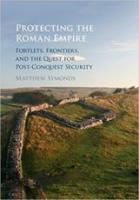
CUP (2018) h/b £75 (ISBN97811084421533)
Archaeologists have yet to come across the inscription MAX. FAC at Housesteads or any other of the fortlets along Hadrian’s Wall but we now know much more about how the Romans protected and controlled their frontiers. Brexiteers, Remoaners, and modern military strategists too, have much to learn from Matthew Symonds’ comprehensive but very readable study of the Hadrianic and Antonine Walls, and the German and Raetian frontiers.
In this first major survey Symonds pulls together the archaeological, topographical and other evidence of frontier control. How did the fortlets help hold and consolidate conquered territory? Were they essentially defensive, tripwires that could alert larger-scale reinforcements? Or were they also custom posts, policing commercial as well as military traffic along the interconnecting roads? What role did they play in winning hearts and minds of the local population over to the imperium?
These are important questions even today. And not just about how and where we check imported goods and produce and levy customs duties. Our own generals learnt the hard way in Afghanistan’s Helmand province (2002-2014) where networks of Forward Operating Bases (FOBs), each a few kilometres apart, were manned by handfuls of troops, usually at platoon strength but often fewer, and left to get on with it. Immediately they became targets for Taleban attacks, and the constant fighting alienated the local population they were trying to win over. Too slowly it was realised that effective control is possible only in a semi-permissive environment where political and social support, like healthcare and aid, can be deployed alongside military muscle.
The Romans had 4,700 miles of frontier to protect (15 times the length of the Northern Ireland border). Their policy was not entirely uniform: what worked along the German limites varied from practice in the Egyptian desert, fortlets along the Rhine in the Netherlands differed from those watching the Bristol Channel. But Symonds shows clearly that the fortlets were not there to do the serious campaign fighting: they were praesidia, garrisons to assert control, manned by handfuls of auxiliaries (cavalry and infantry), and charged with patrolling, intelligence-gathering, logistics including mail, traffic-control, signalling, as well as providing general deterrence against bandits and guerrillas.
Positioning was critical, so that they could signal to each other and obtain help quickly. Symonds also shows how well some were sited to exert maximum control of the surrounding terrain. Others had huge appended areas, presumably wagon parks like modern service stations, handling private trade as well as military supply convoys.
These were often remote, unpopular postings, rotating troops from further afield. Their official guidance about calendars of dates to be observed and appropriate sacrifices didn’t exclude scope for local liturgies. But there’s little evidence to date of these mini-garrisons playing any more than the role of military presence. Though some fortlets have differently designed entrances designs, they don’t appear to have been formal customs posts. Nor do we see much to prove they were doing deals with local chiefs or promoting economic and social integration with already pacified areas (there’s even less evidence of villas and new townships appearing between the two Walls before the Antonine one was abandoned).
Symonds tackles some trickier questions too. Was the Gask Ridge built to protect a pacified Fife or the English border further south? What triggered the critical ‘fort decision’—to switch to a hard border with 9,000 troops instead of 2,500, up on Hadrian’s Wall itself? Was the Tipalt-Irthing Gap on the western side really a weak point, on a par with NATO’s worrisome Suwalki Gap? He shows how the Roman military learnt and adapted along the way, incorporating key lessons from Hadrian’s Wall into the Antonine Wall further north.
Fortlets came and went, abandoned as areas were pacified or the frontier shifted. But they worked their purpose, exercising control with minimum numbers and maximum efficiency. As border controls go, neither particularly ‘hard’ or ‘soft’: simply smart.
Michael Fallon was UK Defence Secretary 2014-17.
